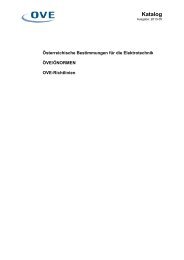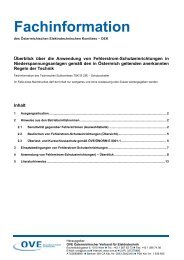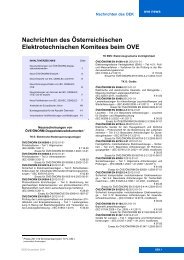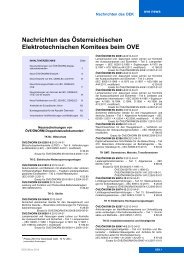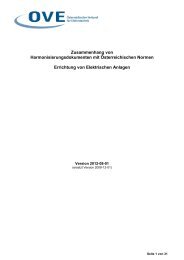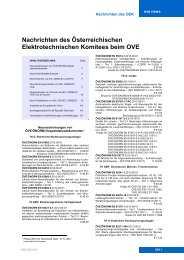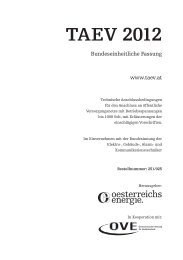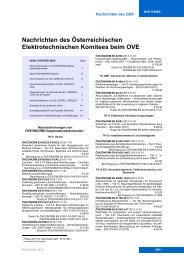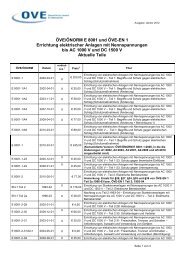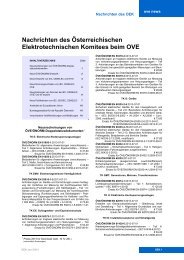Primer on Standards - OEK - OVE
Primer on Standards - OEK - OVE
Primer on Standards - OEK - OVE
- No tags were found...
Create successful ePaper yourself
Turn your PDF publications into a flip-book with our unique Google optimized e-Paper software.
In the case of a European standard (not related to the requirements of anyDirective), the A-deviati<strong>on</strong>s remain valid until the moment this legislati<strong>on</strong> hasbeen removed.Just like in the case of special nati<strong>on</strong>al c<strong>on</strong>diti<strong>on</strong>s, A-deviati<strong>on</strong>s are also an integralpart of the European Standard (annexed to it) letting every<strong>on</strong>e know about thepossible changes to be applied should a product be introduced in a listed country.In any case, special nati<strong>on</strong>al c<strong>on</strong>diti<strong>on</strong>s and A-deviati<strong>on</strong>s are not necessarilynegative for they are both treated as an integral comp<strong>on</strong>ent to the text. CENELECis in no case the cause of the problem. It merely highlights the existence of aninc<strong>on</strong>venience that must be taken into account by manufacturers, and <strong>on</strong>e that,if necessary, should be solved by either European or nati<strong>on</strong>al Authorities (thelatter in case of n<strong>on</strong>-harm<strong>on</strong>ized standards).CENELEC and the IECCENELEC also works in close cooperati<strong>on</strong> with the IEC, the Internati<strong>on</strong>al ElectrotechnicalCommittee, as <strong>on</strong>e of our main policies is to develop standards with aglobal applicati<strong>on</strong>. In this sense, many IEC <strong>Standards</strong> become CENELEC <strong>Standards</strong>(about 66% of CENELEC <strong>Standards</strong> are identical to those of the IEC).This str<strong>on</strong>g relati<strong>on</strong> is first of all illustrated by the fact that the 22 CENELECMembers are also IEC Members. Since the start of its existence, CENELEC hasused the publicati<strong>on</strong>s and draft documents issued by IEC as the most importantsource of reference documents for the preparati<strong>on</strong> of its European <strong>Standards</strong>.The process by which European standardizati<strong>on</strong> items are offered to the IEC forpossible internati<strong>on</strong>al standardizati<strong>on</strong> is established in the Dresden Agreement.It comprises a chapter <strong>on</strong> the comm<strong>on</strong> planning of work, whereby each new workitem identified at European level can be offered to IEC provided the work can becompleted in a defined time period, and a chapter <strong>on</strong> parallel procedures, providingfor simultaneous publicati<strong>on</strong> of identical <strong>Standards</strong>. This agreement also guaranteesthat any standard already ratified by CENELEC will be automatically offered tothe IEC for possible acceptance at internati<strong>on</strong>al level.But here we now find the main difference between IEC <strong>Standards</strong> and CENELEC’s.IEC does not require its members to implement the standards published whilethose very same IEC <strong>Standards</strong>, under an EN reference this time but samenumbering as the IEC, must be implemented by all CENELEC countries. Thismethod, at European level, also guarantees that any c<strong>on</strong>flicting nati<strong>on</strong>al standard22 CENELEC. <str<strong>on</strong>g>Primer</str<strong>on</strong>g> <strong>on</strong> <strong>Standards</strong>



